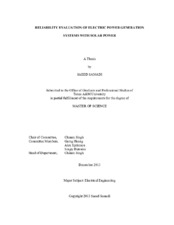| dc.description.abstract | Conventional power generators are fueled by natural gas, steam, or water flow. These generators can respond to fluctuating load by varying the fuel input that is done by a valve control. Renewable power generators such as wind or solar, however, are not controllable since their fuel sources are intermittent in nature. This creates difficulties for designing generation systems having renewable sources. Therefore, a mechanism is needed to predict their power outputs and evaluate the generation system reliability. This information is used to calculate the reliability indices such as Loss of Load Expectation (LOLE), frequency of capacity deficiency, and Expected Unserved Energy (EUE). These indices help to estimate to what extent renewable power plants with intermittent sources can substitute for other power generations in the system while maintaining the same reliability standards. This study is used in generation planning of power systems with intermittent sources.
The primary objective of this thesis is to study reliability evaluation of generation systems including Photovoltaic (PV) and Concentrated Solar Power (CSP) plants. Unit models of PV and CSP are developed first, and then generation system model is constructed to evaluate the reliability of generation systems.
In addition to reliability indices calculations, a methodology is developed to evaluate the capacity credit of PV and CSP plants. This is accomplished by calculating the Effective Load Carrying Capability (ELCC) of these plants. ELCC is the extra load that can be served after addition of the solar power plant to the conventional system. The capacity credit information, in addition to its use in generation system planning, can also be used for cost comparison between conventional power plants and solar power plants.
The methodology developed in this thesis is applied to IEEE Reliability Test System (IEEE-RTS) to study the system reliability for different penetration levels of solar power and evaluate their capacity credits. It is found that generation system reliability drops as solar power penetration level increases. Also, solar plant capacity credit drops as its penetration level increases in generation system. | en |


